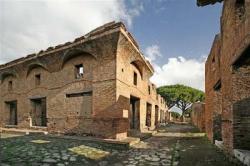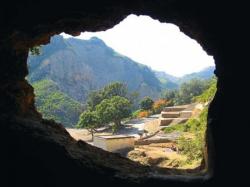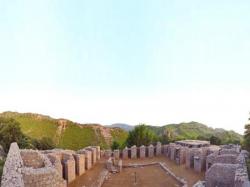- 08 SEPTEMBRE
- INDI-UNI :ANTHROPOLOGIE - ARCHEOLOGIE
INSCRIPTION 2011 – 2012 COURS A DISTANCE
REGISTRATION 2011 – 2012 ONLINE COURSES
- FRANCE – Reims - La Porte de Mars, Arc de Triomphe antique, était loin d'être la seule. Trois autres portes avaient été intégrées au IVe siècle : la Porte Bazée, la Porte Cérès et la Porte de Vesle. « Ces quatre portes délimitaient la partie la plus importante de la ville ancienne (à peine 60 ha) mais la ville romaine s'étendait bien au-delà, sur environ 600 ha », explique Olivier Rigaud, du « Reims Histoire Archéologie ». Entre le XIIIe et le XIVe siècle, une seconde grande muraille est édifiée : l'arc antique est muré dans ces remparts, une autre « Porte de Mars » est ouverte à quelques mètres de là, qui fonctionnera jusqu'à la démolition des remparts en 1849. C'est cette porte qui a été retrouvée lors des fouilles du Boulingrin. Les vestiges de l'enceinte médiévale sont encore visibles à la butte Saint-Nicaise, comme l'explique Patrick Prillieux, du Groupe d'études archéologiques de Champagne-Ardenne, qui a retracé l'histoire des deux pôles de l'enceinte, et proposera de la découvrir lors des Journées du Patrimoine. Il est possible de visualiser les détails du quartier du Boulingrin grâce aux plans qu'Ernest Kalas, architecte et artiste, a entrepris dès 1910. « Son génie était de faire des plans de façon très schématique, qui, grâce à des légendes très fournies, mettaient en évidence, de période en période, ce qui avait été modifié dans la ville », explique Alain Cottez, président de la Société des Amis du Vieux Reims. C'est un peu le travail qu'entreprend aussi, avec ses « diatopes », Dominique Pargny, du Groupe d'étude sur les géomatériaux et environnements naturels anthropiques et archéologiques : « On superpose les plans anciens en une sorte de « millefeuille » que l'on regarde par transparence. En les associant à Google Earth®, on arrive à un résultat surprenant ».
http://www.lunion.presse.fr/article/autres-actus/les-portes-de-mars-retrouvees
- ITALIE –  Ostie - The remains of a harbour city that was one of the most important ports in Ancient Rome is to undergo a major surveying project that will allow for complete verification of its established control points and a new GNSS-based coordinate system. Ostia Antica, which is sited at the mouth of the Tiber River and is a major Roman archaeological site, was prioritised for the survey by the Superintendent of the Archaeological Heritage of Rome due to its historic importance. The city was founded in 620 BC as a military base and, as Rome's importance throughout the Mediterranean grew, became the main emporium of Rome, housing a number of important civic buildings. The results of the survey will aid with the management and planning of archaeological projects at the site in the future. Surveyors have said that the additional information will help with the preservation of the location's well-preserved ancient buildings, frescos and mosaics. Precision surveying equipment will be used to check and enhance the control points that currently exist in the site, and will expand the network of points further into the site. The project will also be used as something of an educational tool for the future generations of Italian surveyors. The survey will be included in a technical and scientific study examining the use and capabilities of modern surveying equipment and techniques in the preservation or areas of archaeological and cultural importance. Once complete, the study will be presented to a forthcoming congress of a number of Italy's universities and its archaeological institutes.
Ostie - The remains of a harbour city that was one of the most important ports in Ancient Rome is to undergo a major surveying project that will allow for complete verification of its established control points and a new GNSS-based coordinate system. Ostia Antica, which is sited at the mouth of the Tiber River and is a major Roman archaeological site, was prioritised for the survey by the Superintendent of the Archaeological Heritage of Rome due to its historic importance. The city was founded in 620 BC as a military base and, as Rome's importance throughout the Mediterranean grew, became the main emporium of Rome, housing a number of important civic buildings. The results of the survey will aid with the management and planning of archaeological projects at the site in the future. Surveyors have said that the additional information will help with the preservation of the location's well-preserved ancient buildings, frescos and mosaics. Precision surveying equipment will be used to check and enhance the control points that currently exist in the site, and will expand the network of points further into the site. The project will also be used as something of an educational tool for the future generations of Italian surveyors. The survey will be included in a technical and scientific study examining the use and capabilities of modern surveying equipment and techniques in the preservation or areas of archaeological and cultural importance. Once complete, the study will be presented to a forthcoming congress of a number of Italy's universities and its archaeological institutes.
http://www.surveyequipment.com/
- MAYOTTE – Dzaoudzi - C 'est à coups de pelleteuse que l'histoire de Mayotte refait surface. Le 12 août, à Dzaoudzi, des ouvriers ont découvert des ossements sur le chantier sur lequel un immeuble devait être dressé à la demande de la préfecture. Il s'agissait d'ossements humains très anciens. Une semaine après cette découverte, les travaux ont cessé comme l'avait demandé l'archéologue, Edouard Jacquot. Ce dernier, membre de la direction des affaires culturelles de l'océan Indien, a souhaité la mise en place d'"une fouille de sauvetage" afin d'étudier les vestiges. Ces ossements révèleraient l'existence d'un cimetière musulman. Les têtes sembleraient tournées vers la Mecque, a indiqué Mohamed M'trengueny, attaché territorial de conservation du patrimoine. Cette fouille archéologique n'est pas sans rappeler celle qui a permis de trouver des squelettes entiers dans le cimetière marin de Saint-Paul dans notre île...
http://www.zinfos974.com/Mayotte-Des-ossements-decouverts-a-Dzaoudzi_a31962.html
- FRANCE - Horbourg-Wihr - L’Inrap achève cette semaine trois mois de fouilles archéologiques à Horbourg-Wihr. Marquées par la découverte de structures en bois vieilles de près de 2000 ans, elles ont surtout confirmé l’organisation de la petite cité gallo-romaine située sous Horbourg-Wihr.
http://www.dna.fr/fr/colmar/info/5654696-Horbourg-Wihr-Fouilles-archeologiques-Cernes-millenaires
- PAKISTAN –  Shah Allah Ditta - The ancient caves of Shah Allah Ditta in the suburbs of Islamabad are among the most treasured archaeological sites of the capital that give a past to a city just more than a half century old. However, the site faced threats from land developers had the Capital Development Authority not woken to the danger in time. Located at the gateway to Gandhara civilization and the foothills of the might Himalayas, the capital is home to several archaeological sites, which not only provide a peek into the past but are a treasure for the researchers to uncover facts about this region.The caves in the suburbs of Islamabad are one such place and according to recent studies there might be more of such sites in the area. Earlier, members of the Capital Citizens Committee had raised alarm about the danger the site has been facing and informed CDA Chairperson Imtiaz Inayat Elahi after noticing suspicious activities near the heritage site. They noticed that a restaurant was being planned on the hill above the 2,400-year-old caves and the cluster of Banyan trees at their entrance. Buddhist caves are located on the route leading towards Khanpur next to the shrine of Shah Allah Ditta. Shah Allah Ditta Village is believed to be more then 700 years old and was used as route from Kabul to Gandharan city of Taxila by Sher Shah Suri and other Mughal rulers emperors. Archaeological evidence indicates that the caves and the platform-like formations surrounding the area were first used for meditation by Buddhist monks and later by Hindu sadhus before Muslim ascetics took over during the Mughal period. The road next to the caves that leads to the top of the mountain is said to be built on the exact path followed by Mughal Emperor Sher Shah Suri . Relics of the Buddhist era dating back to the 8th century can be found here along with burnt diyas and trees with amulets tied to them.
Shah Allah Ditta - The ancient caves of Shah Allah Ditta in the suburbs of Islamabad are among the most treasured archaeological sites of the capital that give a past to a city just more than a half century old. However, the site faced threats from land developers had the Capital Development Authority not woken to the danger in time. Located at the gateway to Gandhara civilization and the foothills of the might Himalayas, the capital is home to several archaeological sites, which not only provide a peek into the past but are a treasure for the researchers to uncover facts about this region.The caves in the suburbs of Islamabad are one such place and according to recent studies there might be more of such sites in the area. Earlier, members of the Capital Citizens Committee had raised alarm about the danger the site has been facing and informed CDA Chairperson Imtiaz Inayat Elahi after noticing suspicious activities near the heritage site. They noticed that a restaurant was being planned on the hill above the 2,400-year-old caves and the cluster of Banyan trees at their entrance. Buddhist caves are located on the route leading towards Khanpur next to the shrine of Shah Allah Ditta. Shah Allah Ditta Village is believed to be more then 700 years old and was used as route from Kabul to Gandharan city of Taxila by Sher Shah Suri and other Mughal rulers emperors. Archaeological evidence indicates that the caves and the platform-like formations surrounding the area were first used for meditation by Buddhist monks and later by Hindu sadhus before Muslim ascetics took over during the Mughal period. The road next to the caves that leads to the top of the mountain is said to be built on the exact path followed by Mughal Emperor Sher Shah Suri . Relics of the Buddhist era dating back to the 8th century can be found here along with burnt diyas and trees with amulets tied to them.
http://tribune.com.pk/story/247555/securing-islamabads-past-in-fight-with-greed-heritage-wins-first-round/
- PAKISTAN –  Hazara - Sixteen archaeological sites, 11 in Taxila and five in Hazara Division, have gone to the Khyber-Pakhtunkhwa (K-P) Department of Museum and Archaeology. The archaeological sites in Taxila that have gone to the K-P department are: Jandial Stupa, Jinan Wali Dheri, Badalpur Stupa, Buddhist Monastery of 300 BC (commonly known as Jaulian University), Tofkian Stupa, Mirpur Mound, Sirsukh, Piplian, Chiti, Bhirnmound and Bhamala Stupa. Other sites given to department include Government High School for Boys in Mansehra, Zardheri archaeological site, Ashoka Rocks and others. Archaeological sites in Abbottabad, Swabi, Mardan, Bannu and DI Khan have also been taken over by the provincial government, including the ruins of Takht-i-Bahi in Mardan and the Swat Museum that are enlisted in the World Heritage List of Unesco.
Hazara - Sixteen archaeological sites, 11 in Taxila and five in Hazara Division, have gone to the Khyber-Pakhtunkhwa (K-P) Department of Museum and Archaeology. The archaeological sites in Taxila that have gone to the K-P department are: Jandial Stupa, Jinan Wali Dheri, Badalpur Stupa, Buddhist Monastery of 300 BC (commonly known as Jaulian University), Tofkian Stupa, Mirpur Mound, Sirsukh, Piplian, Chiti, Bhirnmound and Bhamala Stupa. Other sites given to department include Government High School for Boys in Mansehra, Zardheri archaeological site, Ashoka Rocks and others. Archaeological sites in Abbottabad, Swabi, Mardan, Bannu and DI Khan have also been taken over by the provincial government, including the ruins of Takht-i-Bahi in Mardan and the Swat Museum that are enlisted in the World Heritage List of Unesco.
http://tribune.com.pk/story/247563/cultural-heritage-k-p-govt-takes-over-16-archaeological-sites-in-hazara/